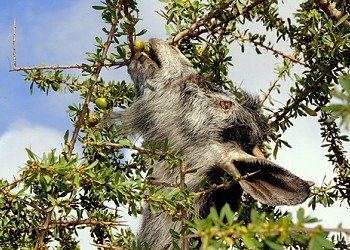
|
|
Argan
tree (Argania spinosa) and goat
|
Argan
- Argania spinosa
The Argan (Argania
spinosa, syn. A. sideroxylon Roem. & Schult.) is a species of tree endemic to the calcareous
semi-desert Sous valley of southwestern Morocco and to the algerian region of
Tindouf. It is the sole species in the genus Argania
and is the only member of the Sapotaceae family occurring north of the
Sahara.
Argania spinosa
is known locally as "the tree of life". It is thought that the
trees date back to the Tertiary period between 65 and 1.6 million years
ago, and at one time grew all over North Africa and southern Europe. An evergreen thorny shrub or
tree, it lives to 150-200 years old,
and it can grow up to 10m from a single gnarled and twisted trunk or multiple
stems. The leaves are small, 2-4 cm long, oval with a rounded apex. The flowers are
small, with five pale yellow-green petals; flowering is in April. The fruit is 2-4 cm long and 1.5-3 cm
broad, with a thick, bitter peel surrounding a sweet-smelling but unpleasantly flavoured layer of pulpy
pericarp. This surrounds the very hard nut, which contains one (occasionally two or
three) small, oil-rich seeds. The fruit takes over a year to mature, ripening in June to July of the following
year.
The argan tree can live to at least 250 years
old, and although
it starts producing fruit after about five years, it takes a further 25 before it is in full
production, which lasts between 30 and 60 years in total. For full production argans require 50mm a
year, though they can survive on as little as 15mm of water a year. During extreme
conditions the tree becomes dormant, regenerating once the rains return. To survive such dry conditions they sinks their roots deep into
the water table some 30m down. The tree also has shallow roots called
tivotantes, which absorb rainfall. Unsurprisingly, little else will grow
nearby as the trees are renowned for taking up all water available.
In some parts of
Morocco, Argan takes the place of the Olive as a source of forage, oil, timber and fuel in Berber
society. Especially near Essaouira, the argan tree is frequently climbed by
goats. The argan tree branches
carry vicious spines, which prove an effective deterrent to all wishing to pick the
fruit, apart from the fearless goats; local people
wait for the fruits to fall to the ground before harvesting.
Argan fruit falls in July, when black and
dry. Until that time, goats are kept out of the argan woodlands by
wardens. Rights to collect the fruit are controlled by law and village
traditions. The leftover nut is gathered after consumption by goats, but the oil produced from these nuts has an unpleasant
taste, and is not used for human consumption. Thereís an urban legend that the argan
nuts have to pass through a goatís gut before being collected out of their
dung. Some fruit are harvested that way, but it does
taint the oil with an unmistakable smell of goat.
The
oil which prodused without "goats help" is pure and is the
famous Argan oil. Argan oil is slightly darker than olive oil, with a reddish
tinge. It can be used for cooking and is claimed to have various medicinal
properties, such as lowering cholesterol levels, stimulating circulation and strengthening the bodyís natural
defences. Internationally, there is some interest in its possible cosmetic
uses.
The production of argan oil, which is still mostly done by traditional
methods, is a lengthy process. Each nut has to be cracked open to remove the
kernels, and it is said that producing one litre of oil takes 20 hours'
work.
The residue from the kernels after oil extraction is a thick chocolate-coloured paste called
"amlou" which is sweetened and served as a dip for bread at breakfast time in Berber
households. It flavour is similar to that of peanut butter.
The wood and nut-shells of the argan tree are burned for cooking; the wood is also used decoratively in some of the inlaid boxes which are made in
Essaouira.
Households that make their own argan oil tend to use if for general
cooking. Because it is expensive to buy, others may use it more sparingly - flavouring
salads, for example. A few drops stirred into couscous just before serving give it a
rich, nutty aroma.
Argan production is still basically a cottage industry, managed largely by
women. But many people believe that if the oil became better known it could provide more employment in the region as well as enhancing the
environment.
The surface area and the density of the groves of argan trees are,
however, receding in an alarming manner. In less than a century, more than a third of the argan forest has disappeared and the average density of the forest has gone from 100 to 30 trees per
hectare. The arganeraie forests now cover some 8,280 km≤ and are designated as a UNESCO Biosphere
reserve. However, research work has shown that the argan tree is not a fossil which is slowly dying
out, but is, on the contrary the tree of the future for certain arid
regions.
As now the sight of goats in trees is controled and may become increasingly
rare, it is hoped the argan groves will once
more clothe the land, providing sustenance for the Berbers and safeguarding the future of an unlikely and versatile plant
and the green curtain at the doorway to the Sahara.
Source:
http://en.wikipedia.org/wiki/Argan
http://www.al-bab.com/maroc/env/argan.htm
http://www.mondeberbere.com/science/argan/argan_intro_en.htm
http://www.wildwoodgroves.com/GI121_argan_oil_10se%20indd.pdf
